Economics Case Study: Climate Change, Market Failure, and Solutions
VerifiedAdded on 2020/03/01
|18
|3901
|67
Case Study
AI Summary
This economics case study delves into the multifaceted issue of climate change, examining its origins, far-reaching consequences, and potential solutions through an economic lens. The study begins by highlighting the increase in greenhouse gas emissions, particularly carbon dioxide (CO2), and its correlation with rising global temperatures. It then explores the dire consequences of climate change, including rising sea levels, extreme weather events, and threats to ecosystems and human health. The case study identifies market failures associated with climate change, specifically the greenhouse-gas externality, where the costs of CO2 emissions are not fully accounted for. Finally, it proposes several solutions, such as transitioning to cleaner energy sources, improving energy efficiency, shifting consumer demand, promoting reforestation, and implementing geologic carbon sequestration to mitigate the impacts of global warming and promote sustainable economic practices. This analysis provides a comprehensive understanding of the economic challenges and opportunities related to climate change.
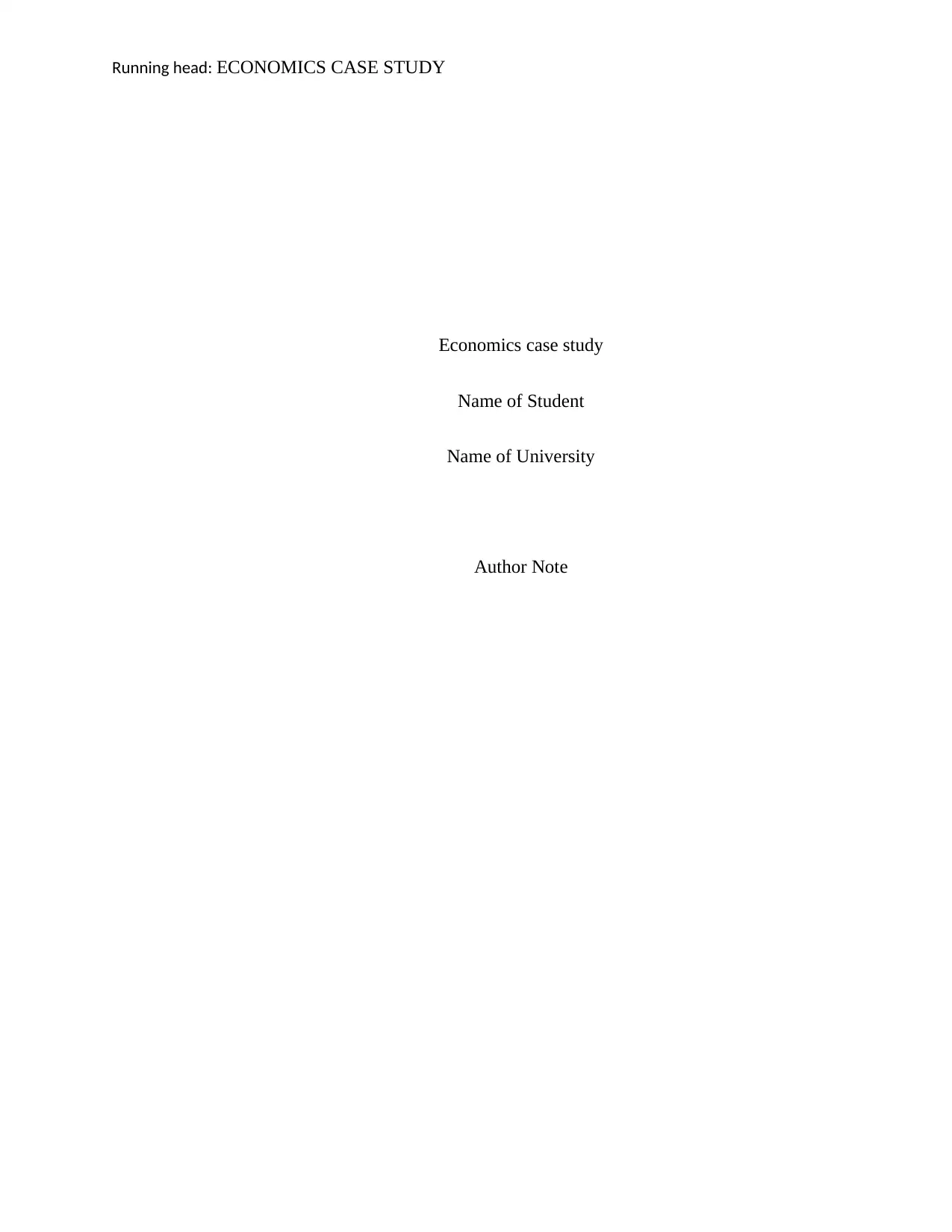
Running head: ECONOMICS CASE STUDY
Economics case study
Name of Student
Name of University
Author Note
Economics case study
Name of Student
Name of University
Author Note
Paraphrase This Document
Need a fresh take? Get an instant paraphrase of this document with our AI Paraphraser
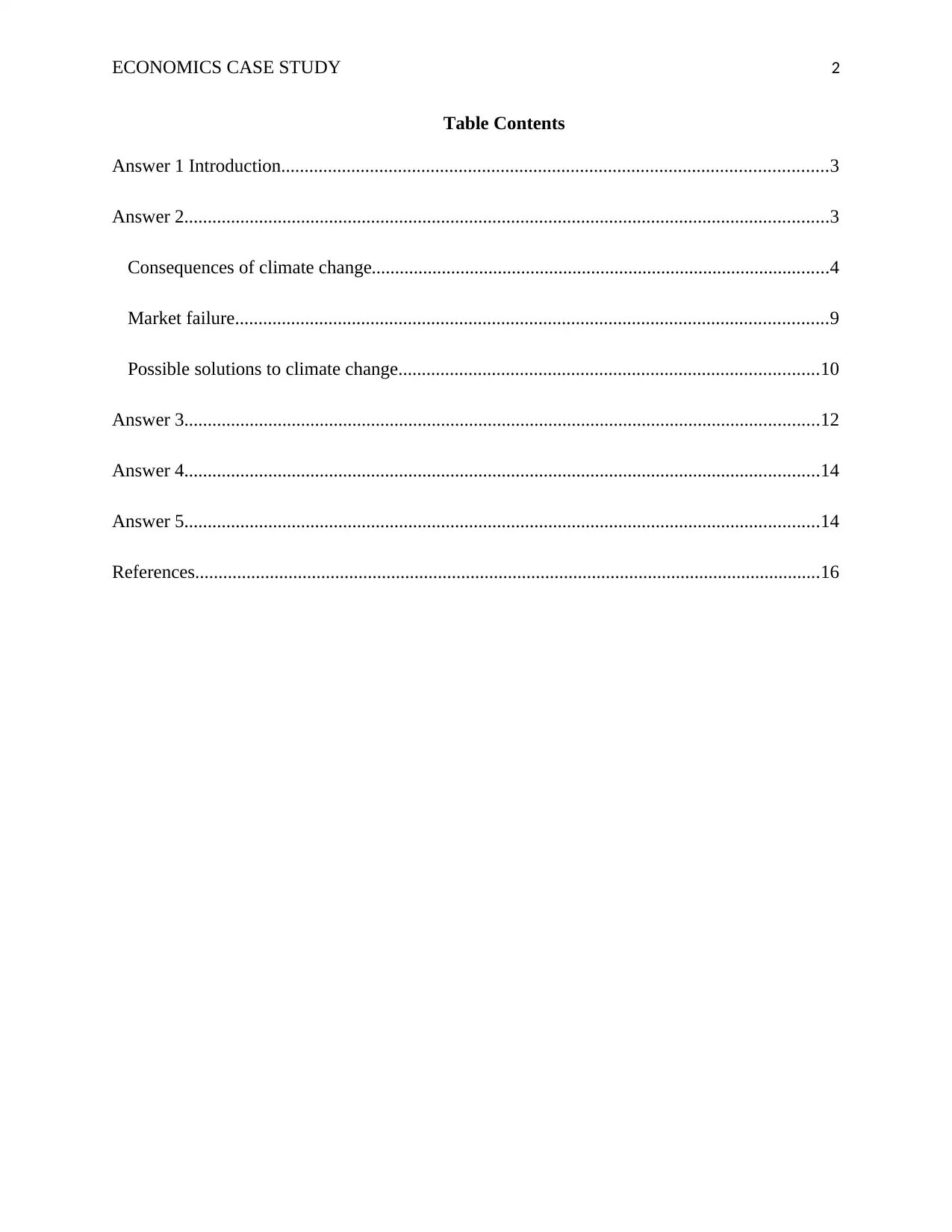
ECONOMICS CASE STUDY 2
Table Contents
Answer 1 Introduction.....................................................................................................................3
Answer 2..........................................................................................................................................3
Consequences of climate change..................................................................................................4
Market failure...............................................................................................................................9
Possible solutions to climate change..........................................................................................10
Answer 3........................................................................................................................................12
Answer 4........................................................................................................................................14
Answer 5........................................................................................................................................14
References......................................................................................................................................16
Table Contents
Answer 1 Introduction.....................................................................................................................3
Answer 2..........................................................................................................................................3
Consequences of climate change..................................................................................................4
Market failure...............................................................................................................................9
Possible solutions to climate change..........................................................................................10
Answer 3........................................................................................................................................12
Answer 4........................................................................................................................................14
Answer 5........................................................................................................................................14
References......................................................................................................................................16
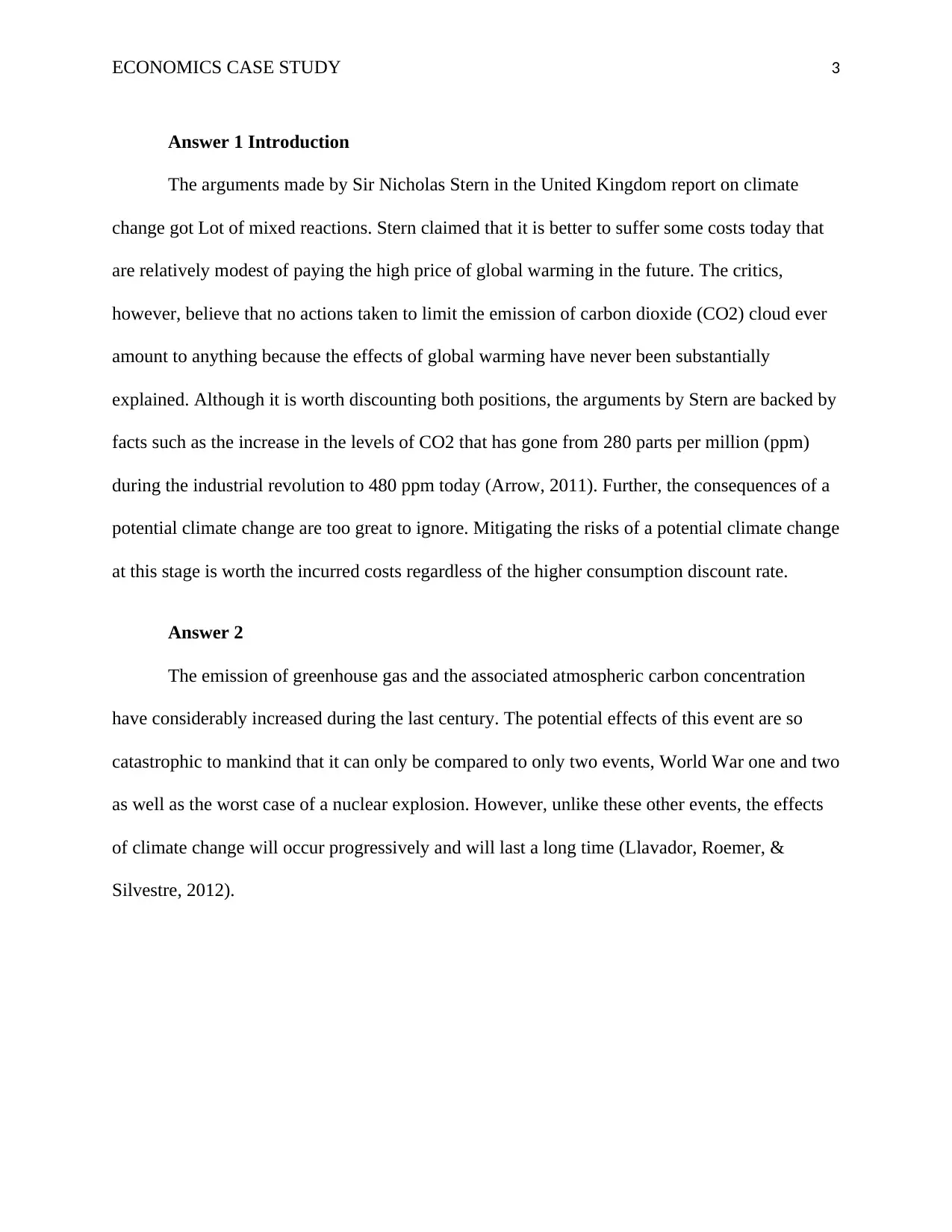
ECONOMICS CASE STUDY 3
Answer 1 Introduction
The arguments made by Sir Nicholas Stern in the United Kingdom report on climate
change got Lot of mixed reactions. Stern claimed that it is better to suffer some costs today that
are relatively modest of paying the high price of global warming in the future. The critics,
however, believe that no actions taken to limit the emission of carbon dioxide (CO2) cloud ever
amount to anything because the effects of global warming have never been substantially
explained. Although it is worth discounting both positions, the arguments by Stern are backed by
facts such as the increase in the levels of CO2 that has gone from 280 parts per million (ppm)
during the industrial revolution to 480 ppm today (Arrow, 2011). Further, the consequences of a
potential climate change are too great to ignore. Mitigating the risks of a potential climate change
at this stage is worth the incurred costs regardless of the higher consumption discount rate.
Answer 2
The emission of greenhouse gas and the associated atmospheric carbon concentration
have considerably increased during the last century. The potential effects of this event are so
catastrophic to mankind that it can only be compared to only two events, World War one and two
as well as the worst case of a nuclear explosion. However, unlike these other events, the effects
of climate change will occur progressively and will last a long time (Llavador, Roemer, &
Silvestre, 2012).
Answer 1 Introduction
The arguments made by Sir Nicholas Stern in the United Kingdom report on climate
change got Lot of mixed reactions. Stern claimed that it is better to suffer some costs today that
are relatively modest of paying the high price of global warming in the future. The critics,
however, believe that no actions taken to limit the emission of carbon dioxide (CO2) cloud ever
amount to anything because the effects of global warming have never been substantially
explained. Although it is worth discounting both positions, the arguments by Stern are backed by
facts such as the increase in the levels of CO2 that has gone from 280 parts per million (ppm)
during the industrial revolution to 480 ppm today (Arrow, 2011). Further, the consequences of a
potential climate change are too great to ignore. Mitigating the risks of a potential climate change
at this stage is worth the incurred costs regardless of the higher consumption discount rate.
Answer 2
The emission of greenhouse gas and the associated atmospheric carbon concentration
have considerably increased during the last century. The potential effects of this event are so
catastrophic to mankind that it can only be compared to only two events, World War one and two
as well as the worst case of a nuclear explosion. However, unlike these other events, the effects
of climate change will occur progressively and will last a long time (Llavador, Roemer, &
Silvestre, 2012).
⊘ This is a preview!⊘
Do you want full access?
Subscribe today to unlock all pages.

Trusted by 1+ million students worldwide
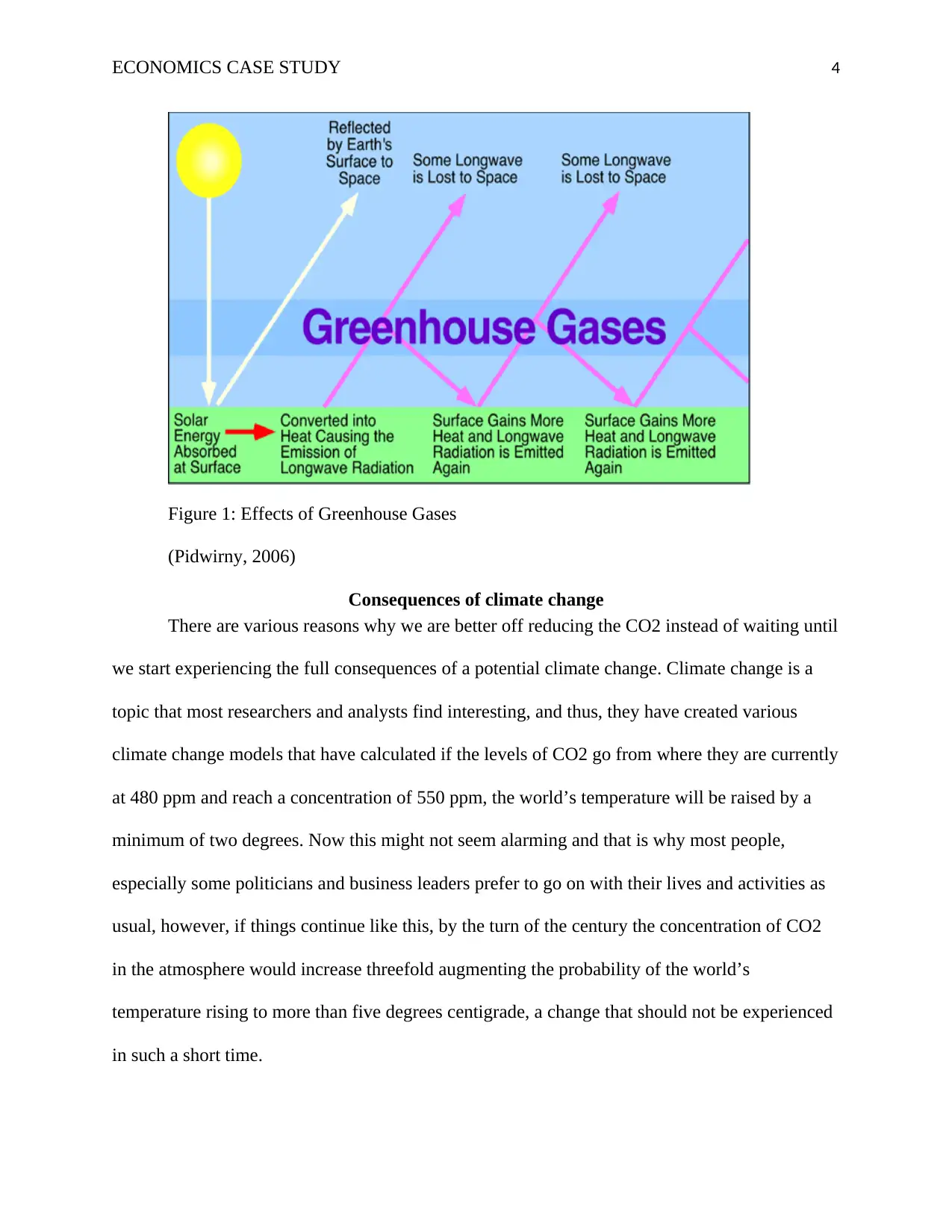
ECONOMICS CASE STUDY 4
Figure 1: Effects of Greenhouse Gases
(Pidwirny, 2006)
Consequences of climate change
There are various reasons why we are better off reducing the CO2 instead of waiting until
we start experiencing the full consequences of a potential climate change. Climate change is a
topic that most researchers and analysts find interesting, and thus, they have created various
climate change models that have calculated if the levels of CO2 go from where they are currently
at 480 ppm and reach a concentration of 550 ppm, the world’s temperature will be raised by a
minimum of two degrees. Now this might not seem alarming and that is why most people,
especially some politicians and business leaders prefer to go on with their lives and activities as
usual, however, if things continue like this, by the turn of the century the concentration of CO2
in the atmosphere would increase threefold augmenting the probability of the world’s
temperature rising to more than five degrees centigrade, a change that should not be experienced
in such a short time.
Figure 1: Effects of Greenhouse Gases
(Pidwirny, 2006)
Consequences of climate change
There are various reasons why we are better off reducing the CO2 instead of waiting until
we start experiencing the full consequences of a potential climate change. Climate change is a
topic that most researchers and analysts find interesting, and thus, they have created various
climate change models that have calculated if the levels of CO2 go from where they are currently
at 480 ppm and reach a concentration of 550 ppm, the world’s temperature will be raised by a
minimum of two degrees. Now this might not seem alarming and that is why most people,
especially some politicians and business leaders prefer to go on with their lives and activities as
usual, however, if things continue like this, by the turn of the century the concentration of CO2
in the atmosphere would increase threefold augmenting the probability of the world’s
temperature rising to more than five degrees centigrade, a change that should not be experienced
in such a short time.
Paraphrase This Document
Need a fresh take? Get an instant paraphrase of this document with our AI Paraphraser
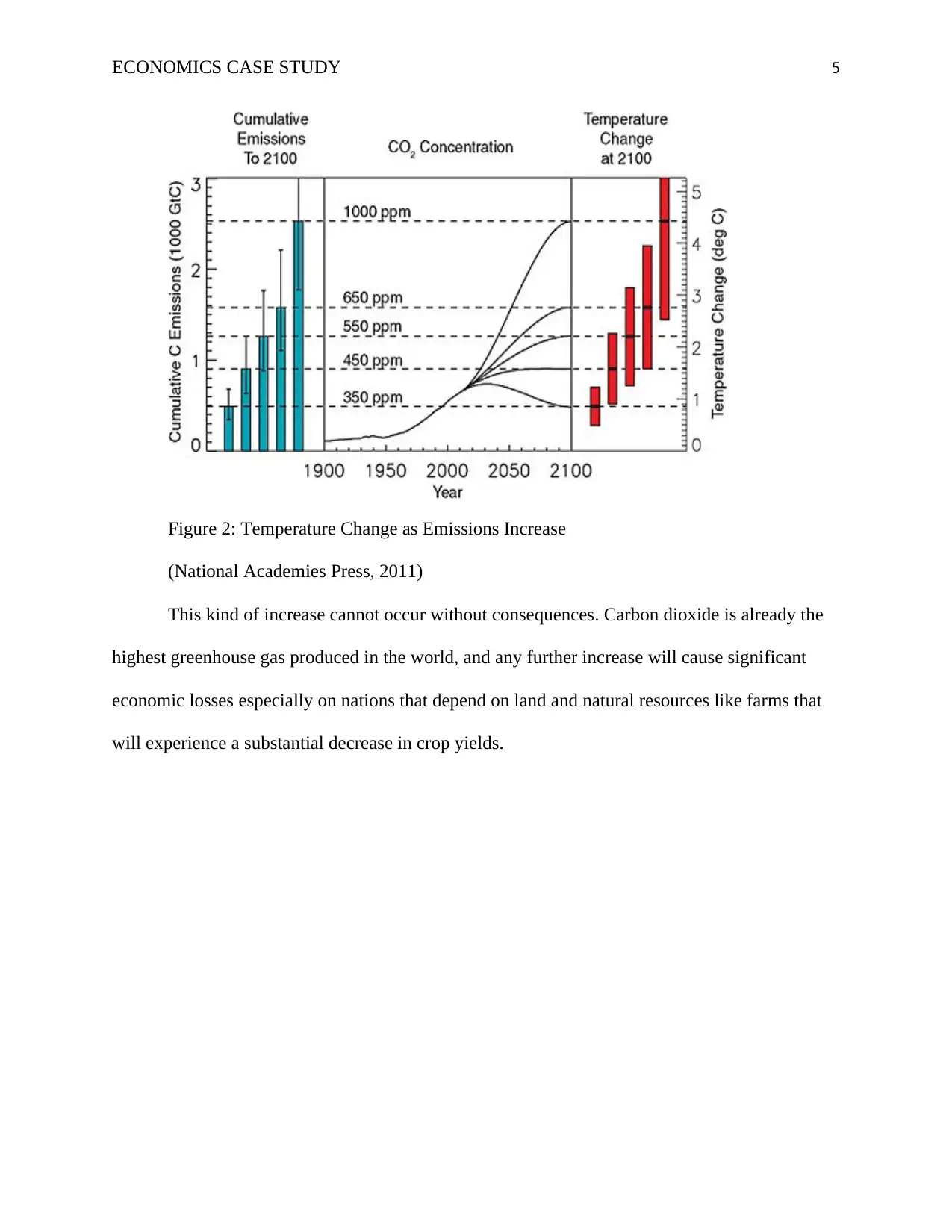
ECONOMICS CASE STUDY 5
Figure 2: Temperature Change as Emissions Increase
(National Academies Press, 2011)
This kind of increase cannot occur without consequences. Carbon dioxide is already the
highest greenhouse gas produced in the world, and any further increase will cause significant
economic losses especially on nations that depend on land and natural resources like farms that
will experience a substantial decrease in crop yields.
Figure 2: Temperature Change as Emissions Increase
(National Academies Press, 2011)
This kind of increase cannot occur without consequences. Carbon dioxide is already the
highest greenhouse gas produced in the world, and any further increase will cause significant
economic losses especially on nations that depend on land and natural resources like farms that
will experience a substantial decrease in crop yields.
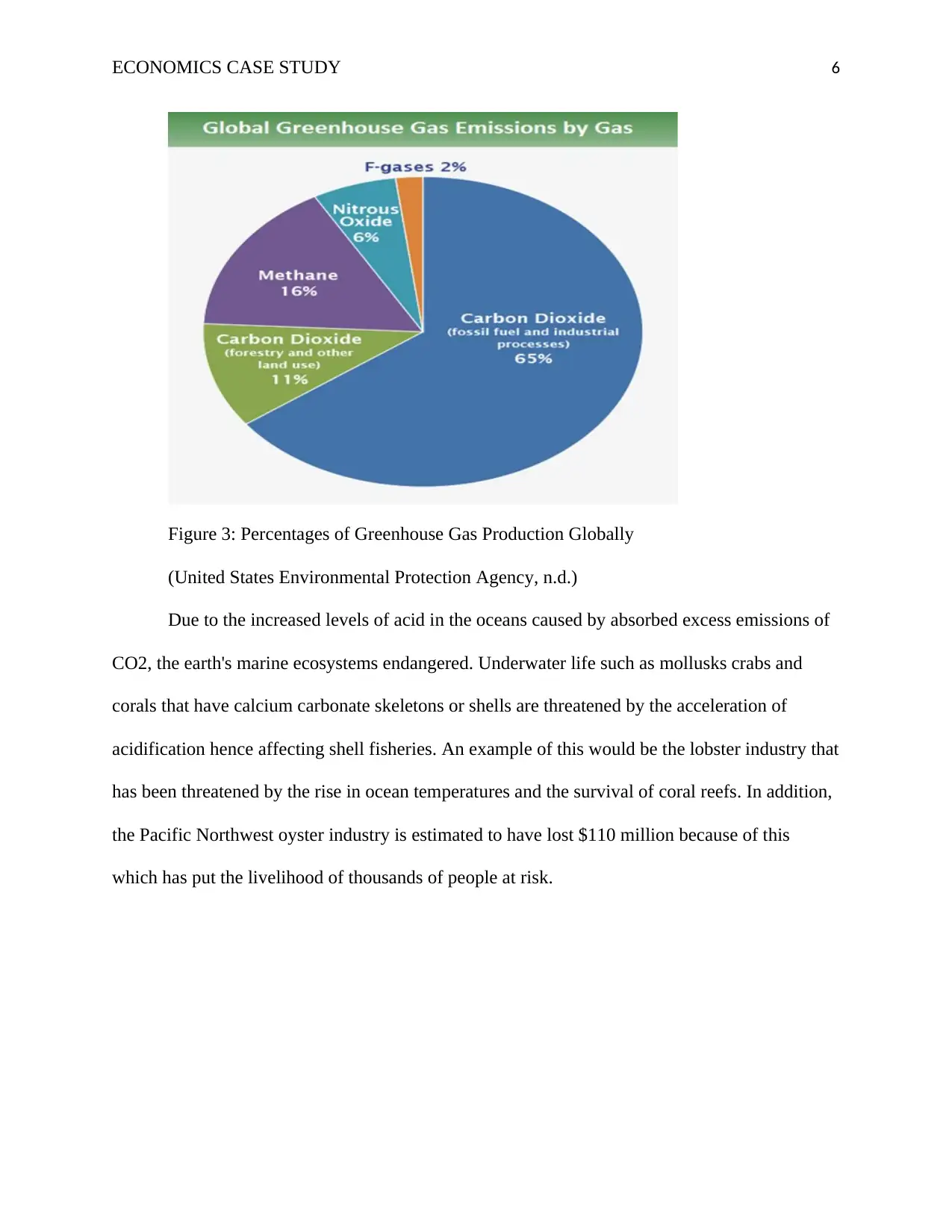
ECONOMICS CASE STUDY 6
Figure 3: Percentages of Greenhouse Gas Production Globally
(United States Environmental Protection Agency, n.d.)
Due to the increased levels of acid in the oceans caused by absorbed excess emissions of
CO2, the earth's marine ecosystems endangered. Underwater life such as mollusks crabs and
corals that have calcium carbonate skeletons or shells are threatened by the acceleration of
acidification hence affecting shell fisheries. An example of this would be the lobster industry that
has been threatened by the rise in ocean temperatures and the survival of coral reefs. In addition,
the Pacific Northwest oyster industry is estimated to have lost $110 million because of this
which has put the livelihood of thousands of people at risk.
Figure 3: Percentages of Greenhouse Gas Production Globally
(United States Environmental Protection Agency, n.d.)
Due to the increased levels of acid in the oceans caused by absorbed excess emissions of
CO2, the earth's marine ecosystems endangered. Underwater life such as mollusks crabs and
corals that have calcium carbonate skeletons or shells are threatened by the acceleration of
acidification hence affecting shell fisheries. An example of this would be the lobster industry that
has been threatened by the rise in ocean temperatures and the survival of coral reefs. In addition,
the Pacific Northwest oyster industry is estimated to have lost $110 million because of this
which has put the livelihood of thousands of people at risk.
⊘ This is a preview!⊘
Do you want full access?
Subscribe today to unlock all pages.

Trusted by 1+ million students worldwide
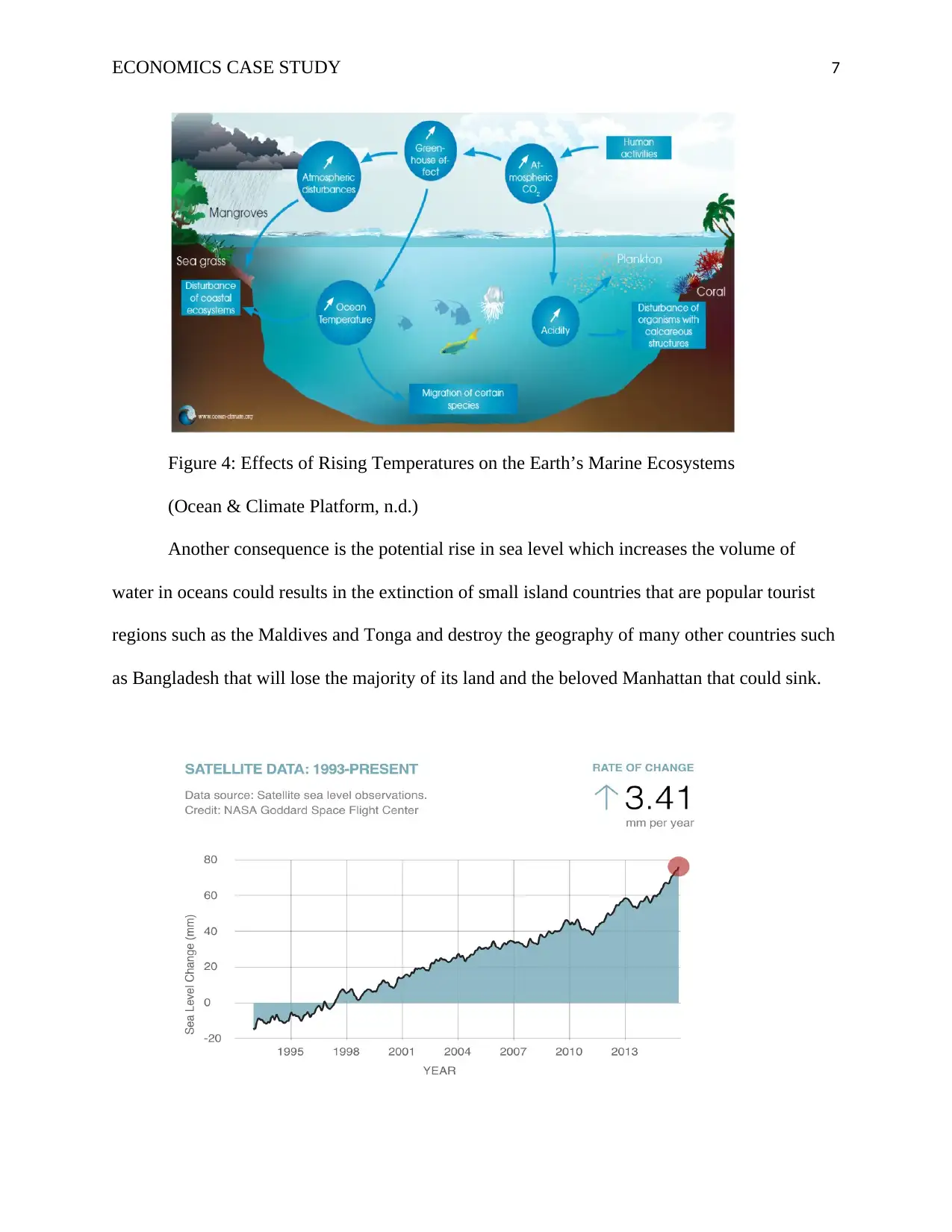
ECONOMICS CASE STUDY 7
Figure 4: Effects of Rising Temperatures on the Earth’s Marine Ecosystems
(Ocean & Climate Platform, n.d.)
Another consequence is the potential rise in sea level which increases the volume of
water in oceans could results in the extinction of small island countries that are popular tourist
regions such as the Maldives and Tonga and destroy the geography of many other countries such
as Bangladesh that will lose the majority of its land and the beloved Manhattan that could sink.
Figure 4: Effects of Rising Temperatures on the Earth’s Marine Ecosystems
(Ocean & Climate Platform, n.d.)
Another consequence is the potential rise in sea level which increases the volume of
water in oceans could results in the extinction of small island countries that are popular tourist
regions such as the Maldives and Tonga and destroy the geography of many other countries such
as Bangladesh that will lose the majority of its land and the beloved Manhattan that could sink.
Paraphrase This Document
Need a fresh take? Get an instant paraphrase of this document with our AI Paraphraser
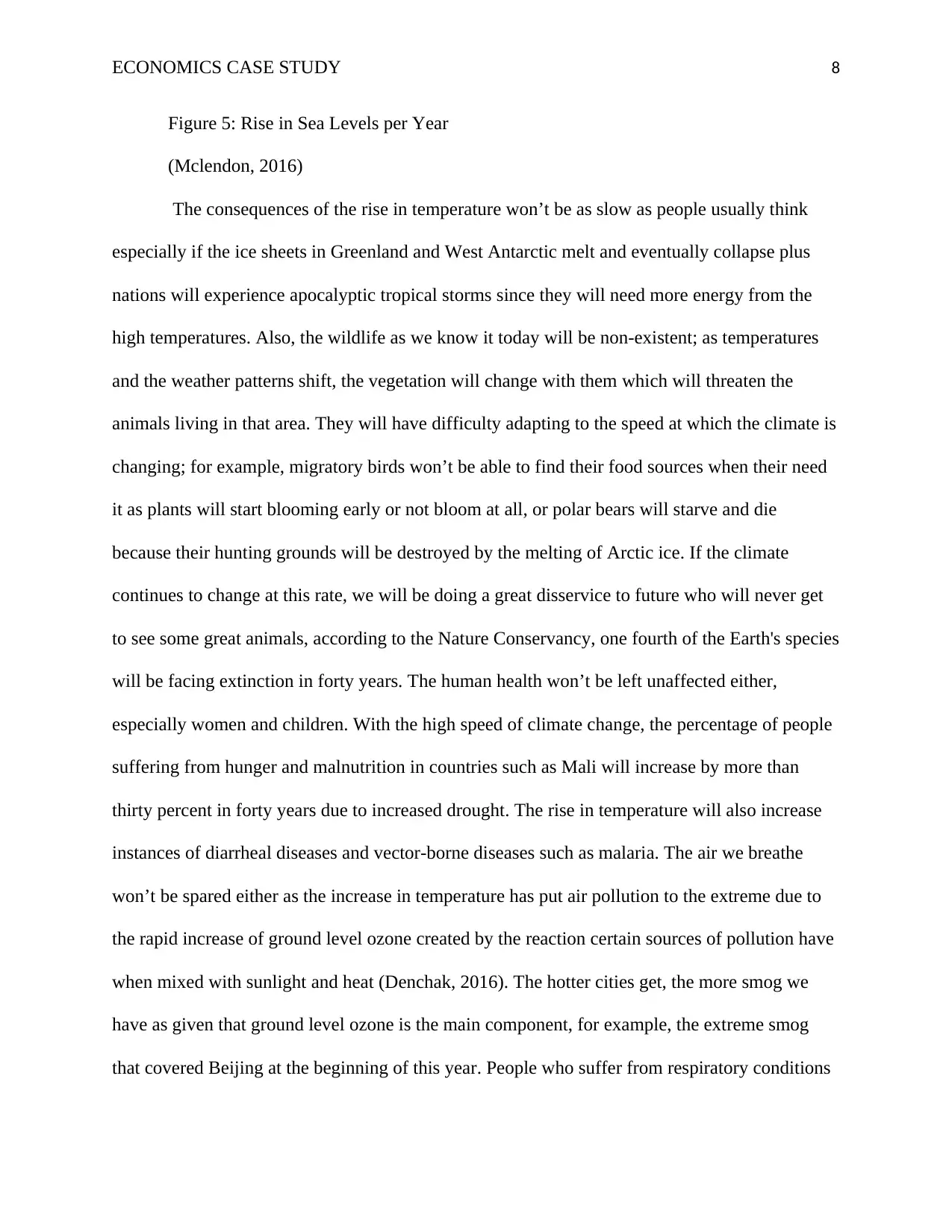
ECONOMICS CASE STUDY 8
Figure 5: Rise in Sea Levels per Year
(Mclendon, 2016)
The consequences of the rise in temperature won’t be as slow as people usually think
especially if the ice sheets in Greenland and West Antarctic melt and eventually collapse plus
nations will experience apocalyptic tropical storms since they will need more energy from the
high temperatures. Also, the wildlife as we know it today will be non-existent; as temperatures
and the weather patterns shift, the vegetation will change with them which will threaten the
animals living in that area. They will have difficulty adapting to the speed at which the climate is
changing; for example, migratory birds won’t be able to find their food sources when their need
it as plants will start blooming early or not bloom at all, or polar bears will starve and die
because their hunting grounds will be destroyed by the melting of Arctic ice. If the climate
continues to change at this rate, we will be doing a great disservice to future who will never get
to see some great animals, according to the Nature Conservancy, one fourth of the Earth's species
will be facing extinction in forty years. The human health won’t be left unaffected either,
especially women and children. With the high speed of climate change, the percentage of people
suffering from hunger and malnutrition in countries such as Mali will increase by more than
thirty percent in forty years due to increased drought. The rise in temperature will also increase
instances of diarrheal diseases and vector-borne diseases such as malaria. The air we breathe
won’t be spared either as the increase in temperature has put air pollution to the extreme due to
the rapid increase of ground level ozone created by the reaction certain sources of pollution have
when mixed with sunlight and heat (Denchak, 2016). The hotter cities get, the more smog we
have as given that ground level ozone is the main component, for example, the extreme smog
that covered Beijing at the beginning of this year. People who suffer from respiratory conditions
Figure 5: Rise in Sea Levels per Year
(Mclendon, 2016)
The consequences of the rise in temperature won’t be as slow as people usually think
especially if the ice sheets in Greenland and West Antarctic melt and eventually collapse plus
nations will experience apocalyptic tropical storms since they will need more energy from the
high temperatures. Also, the wildlife as we know it today will be non-existent; as temperatures
and the weather patterns shift, the vegetation will change with them which will threaten the
animals living in that area. They will have difficulty adapting to the speed at which the climate is
changing; for example, migratory birds won’t be able to find their food sources when their need
it as plants will start blooming early or not bloom at all, or polar bears will starve and die
because their hunting grounds will be destroyed by the melting of Arctic ice. If the climate
continues to change at this rate, we will be doing a great disservice to future who will never get
to see some great animals, according to the Nature Conservancy, one fourth of the Earth's species
will be facing extinction in forty years. The human health won’t be left unaffected either,
especially women and children. With the high speed of climate change, the percentage of people
suffering from hunger and malnutrition in countries such as Mali will increase by more than
thirty percent in forty years due to increased drought. The rise in temperature will also increase
instances of diarrheal diseases and vector-borne diseases such as malaria. The air we breathe
won’t be spared either as the increase in temperature has put air pollution to the extreme due to
the rapid increase of ground level ozone created by the reaction certain sources of pollution have
when mixed with sunlight and heat (Denchak, 2016). The hotter cities get, the more smog we
have as given that ground level ozone is the main component, for example, the extreme smog
that covered Beijing at the beginning of this year. People who suffer from respiratory conditions
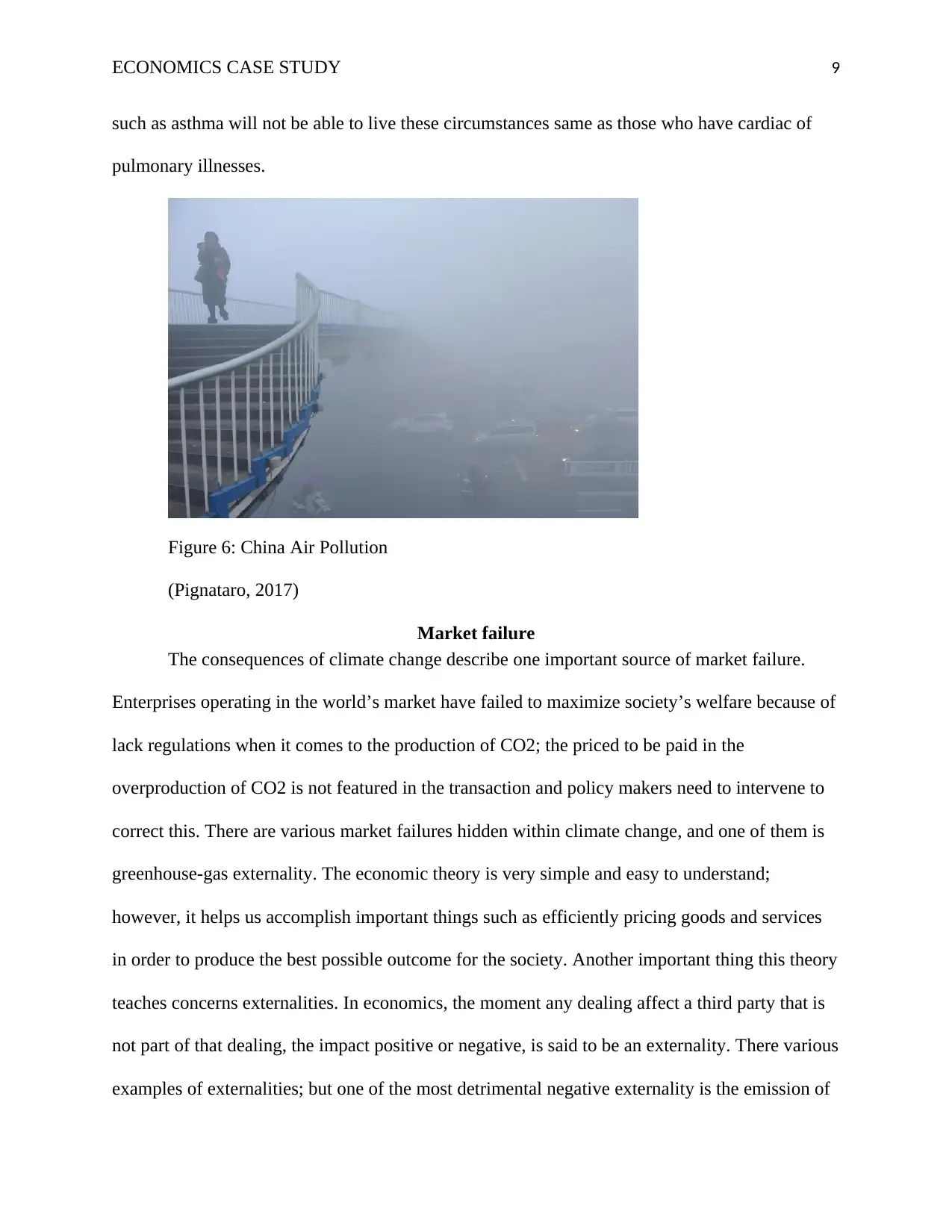
ECONOMICS CASE STUDY 9
such as asthma will not be able to live these circumstances same as those who have cardiac of
pulmonary illnesses.
Figure 6: China Air Pollution
(Pignataro, 2017)
Market failure
The consequences of climate change describe one important source of market failure.
Enterprises operating in the world’s market have failed to maximize society’s welfare because of
lack regulations when it comes to the production of CO2; the priced to be paid in the
overproduction of CO2 is not featured in the transaction and policy makers need to intervene to
correct this. There are various market failures hidden within climate change, and one of them is
greenhouse-gas externality. The economic theory is very simple and easy to understand;
however, it helps us accomplish important things such as efficiently pricing goods and services
in order to produce the best possible outcome for the society. Another important thing this theory
teaches concerns externalities. In economics, the moment any dealing affect a third party that is
not part of that dealing, the impact positive or negative, is said to be an externality. There various
examples of externalities; but one of the most detrimental negative externality is the emission of
such as asthma will not be able to live these circumstances same as those who have cardiac of
pulmonary illnesses.
Figure 6: China Air Pollution
(Pignataro, 2017)
Market failure
The consequences of climate change describe one important source of market failure.
Enterprises operating in the world’s market have failed to maximize society’s welfare because of
lack regulations when it comes to the production of CO2; the priced to be paid in the
overproduction of CO2 is not featured in the transaction and policy makers need to intervene to
correct this. There are various market failures hidden within climate change, and one of them is
greenhouse-gas externality. The economic theory is very simple and easy to understand;
however, it helps us accomplish important things such as efficiently pricing goods and services
in order to produce the best possible outcome for the society. Another important thing this theory
teaches concerns externalities. In economics, the moment any dealing affect a third party that is
not part of that dealing, the impact positive or negative, is said to be an externality. There various
examples of externalities; but one of the most detrimental negative externality is the emission of
⊘ This is a preview!⊘
Do you want full access?
Subscribe today to unlock all pages.

Trusted by 1+ million students worldwide
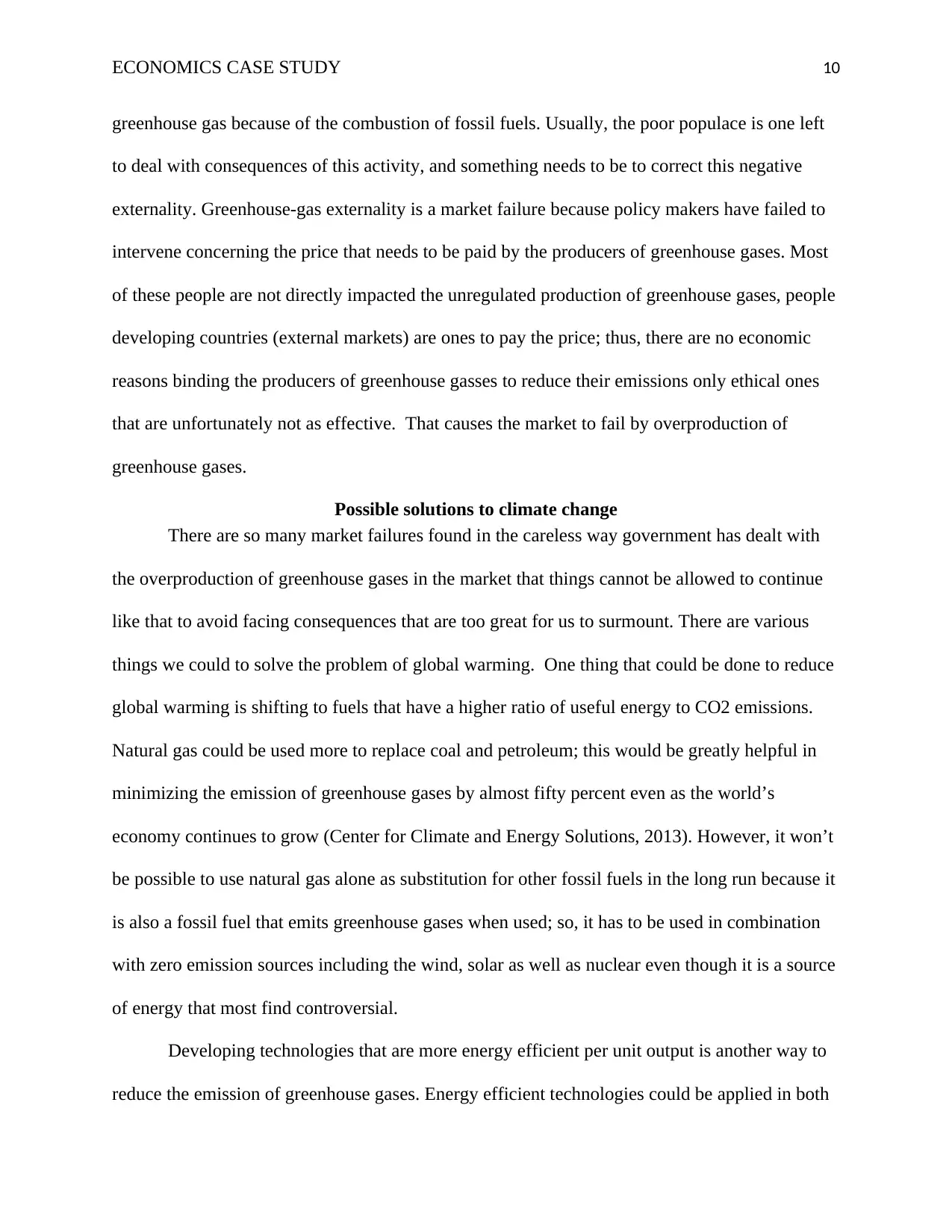
ECONOMICS CASE STUDY 10
greenhouse gas because of the combustion of fossil fuels. Usually, the poor populace is one left
to deal with consequences of this activity, and something needs to be to correct this negative
externality. Greenhouse-gas externality is a market failure because policy makers have failed to
intervene concerning the price that needs to be paid by the producers of greenhouse gases. Most
of these people are not directly impacted the unregulated production of greenhouse gases, people
developing countries (external markets) are ones to pay the price; thus, there are no economic
reasons binding the producers of greenhouse gasses to reduce their emissions only ethical ones
that are unfortunately not as effective. That causes the market to fail by overproduction of
greenhouse gases.
Possible solutions to climate change
There are so many market failures found in the careless way government has dealt with
the overproduction of greenhouse gases in the market that things cannot be allowed to continue
like that to avoid facing consequences that are too great for us to surmount. There are various
things we could to solve the problem of global warming. One thing that could be done to reduce
global warming is shifting to fuels that have a higher ratio of useful energy to CO2 emissions.
Natural gas could be used more to replace coal and petroleum; this would be greatly helpful in
minimizing the emission of greenhouse gases by almost fifty percent even as the world’s
economy continues to grow (Center for Climate and Energy Solutions, 2013). However, it won’t
be possible to use natural gas alone as substitution for other fossil fuels in the long run because it
is also a fossil fuel that emits greenhouse gases when used; so, it has to be used in combination
with zero emission sources including the wind, solar as well as nuclear even though it is a source
of energy that most find controversial.
Developing technologies that are more energy efficient per unit output is another way to
reduce the emission of greenhouse gases. Energy efficient technologies could be applied in both
greenhouse gas because of the combustion of fossil fuels. Usually, the poor populace is one left
to deal with consequences of this activity, and something needs to be to correct this negative
externality. Greenhouse-gas externality is a market failure because policy makers have failed to
intervene concerning the price that needs to be paid by the producers of greenhouse gases. Most
of these people are not directly impacted the unregulated production of greenhouse gases, people
developing countries (external markets) are ones to pay the price; thus, there are no economic
reasons binding the producers of greenhouse gasses to reduce their emissions only ethical ones
that are unfortunately not as effective. That causes the market to fail by overproduction of
greenhouse gases.
Possible solutions to climate change
There are so many market failures found in the careless way government has dealt with
the overproduction of greenhouse gases in the market that things cannot be allowed to continue
like that to avoid facing consequences that are too great for us to surmount. There are various
things we could to solve the problem of global warming. One thing that could be done to reduce
global warming is shifting to fuels that have a higher ratio of useful energy to CO2 emissions.
Natural gas could be used more to replace coal and petroleum; this would be greatly helpful in
minimizing the emission of greenhouse gases by almost fifty percent even as the world’s
economy continues to grow (Center for Climate and Energy Solutions, 2013). However, it won’t
be possible to use natural gas alone as substitution for other fossil fuels in the long run because it
is also a fossil fuel that emits greenhouse gases when used; so, it has to be used in combination
with zero emission sources including the wind, solar as well as nuclear even though it is a source
of energy that most find controversial.
Developing technologies that are more energy efficient per unit output is another way to
reduce the emission of greenhouse gases. Energy efficient technologies could be applied in both
Paraphrase This Document
Need a fresh take? Get an instant paraphrase of this document with our AI Paraphraser
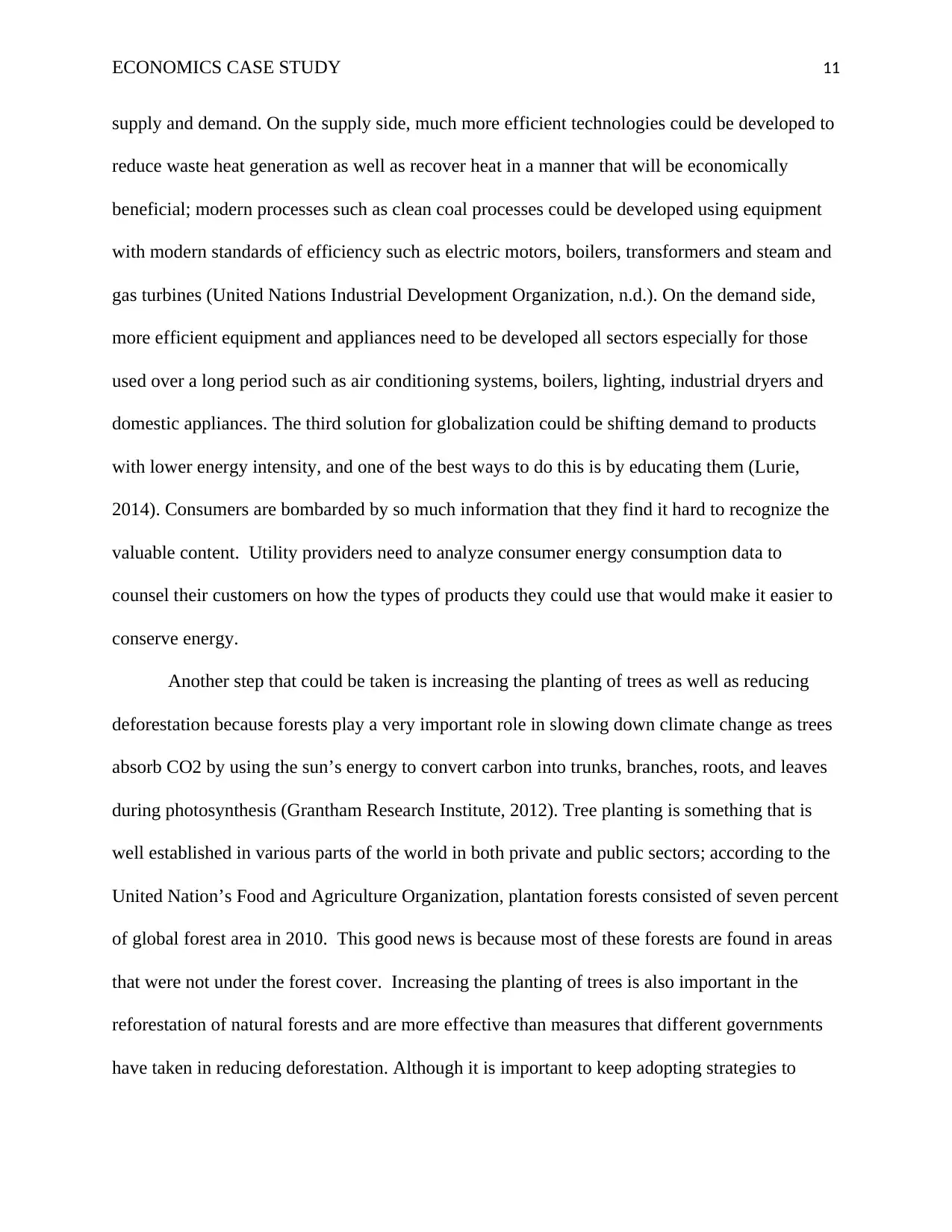
ECONOMICS CASE STUDY 11
supply and demand. On the supply side, much more efficient technologies could be developed to
reduce waste heat generation as well as recover heat in a manner that will be economically
beneficial; modern processes such as clean coal processes could be developed using equipment
with modern standards of efficiency such as electric motors, boilers, transformers and steam and
gas turbines (United Nations Industrial Development Organization, n.d.). On the demand side,
more efficient equipment and appliances need to be developed all sectors especially for those
used over a long period such as air conditioning systems, boilers, lighting, industrial dryers and
domestic appliances. The third solution for globalization could be shifting demand to products
with lower energy intensity, and one of the best ways to do this is by educating them (Lurie,
2014). Consumers are bombarded by so much information that they find it hard to recognize the
valuable content. Utility providers need to analyze consumer energy consumption data to
counsel their customers on how the types of products they could use that would make it easier to
conserve energy.
Another step that could be taken is increasing the planting of trees as well as reducing
deforestation because forests play a very important role in slowing down climate change as trees
absorb CO2 by using the sun’s energy to convert carbon into trunks, branches, roots, and leaves
during photosynthesis (Grantham Research Institute, 2012). Tree planting is something that is
well established in various parts of the world in both private and public sectors; according to the
United Nation’s Food and Agriculture Organization, plantation forests consisted of seven percent
of global forest area in 2010. This good news is because most of these forests are found in areas
that were not under the forest cover. Increasing the planting of trees is also important in the
reforestation of natural forests and are more effective than measures that different governments
have taken in reducing deforestation. Although it is important to keep adopting strategies to
supply and demand. On the supply side, much more efficient technologies could be developed to
reduce waste heat generation as well as recover heat in a manner that will be economically
beneficial; modern processes such as clean coal processes could be developed using equipment
with modern standards of efficiency such as electric motors, boilers, transformers and steam and
gas turbines (United Nations Industrial Development Organization, n.d.). On the demand side,
more efficient equipment and appliances need to be developed all sectors especially for those
used over a long period such as air conditioning systems, boilers, lighting, industrial dryers and
domestic appliances. The third solution for globalization could be shifting demand to products
with lower energy intensity, and one of the best ways to do this is by educating them (Lurie,
2014). Consumers are bombarded by so much information that they find it hard to recognize the
valuable content. Utility providers need to analyze consumer energy consumption data to
counsel their customers on how the types of products they could use that would make it easier to
conserve energy.
Another step that could be taken is increasing the planting of trees as well as reducing
deforestation because forests play a very important role in slowing down climate change as trees
absorb CO2 by using the sun’s energy to convert carbon into trunks, branches, roots, and leaves
during photosynthesis (Grantham Research Institute, 2012). Tree planting is something that is
well established in various parts of the world in both private and public sectors; according to the
United Nation’s Food and Agriculture Organization, plantation forests consisted of seven percent
of global forest area in 2010. This good news is because most of these forests are found in areas
that were not under the forest cover. Increasing the planting of trees is also important in the
reforestation of natural forests and are more effective than measures that different governments
have taken in reducing deforestation. Although it is important to keep adopting strategies to
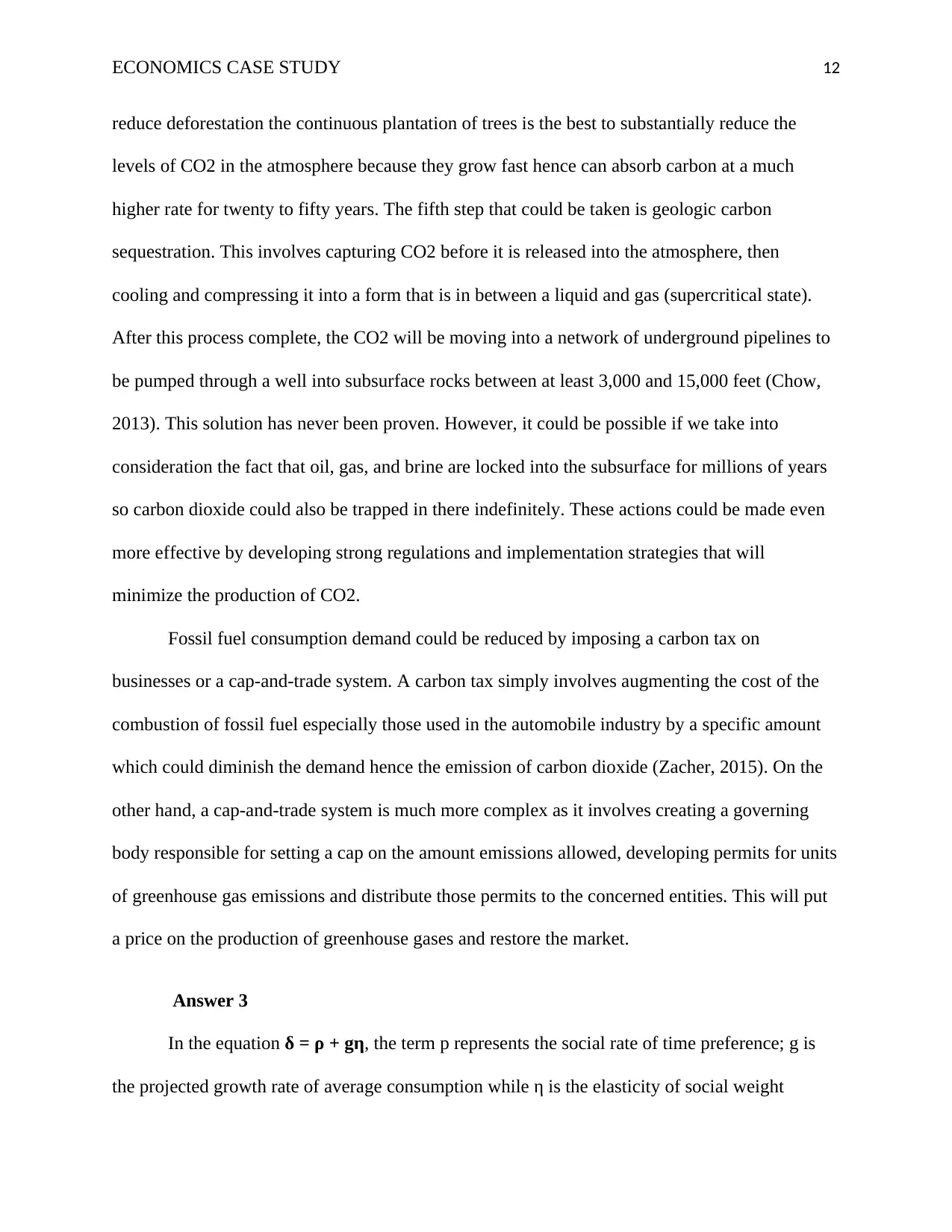
ECONOMICS CASE STUDY 12
reduce deforestation the continuous plantation of trees is the best to substantially reduce the
levels of CO2 in the atmosphere because they grow fast hence can absorb carbon at a much
higher rate for twenty to fifty years. The fifth step that could be taken is geologic carbon
sequestration. This involves capturing CO2 before it is released into the atmosphere, then
cooling and compressing it into a form that is in between a liquid and gas (supercritical state).
After this process complete, the CO2 will be moving into a network of underground pipelines to
be pumped through a well into subsurface rocks between at least 3,000 and 15,000 feet (Chow,
2013). This solution has never been proven. However, it could be possible if we take into
consideration the fact that oil, gas, and brine are locked into the subsurface for millions of years
so carbon dioxide could also be trapped in there indefinitely. These actions could be made even
more effective by developing strong regulations and implementation strategies that will
minimize the production of CO2.
Fossil fuel consumption demand could be reduced by imposing a carbon tax on
businesses or a cap-and-trade system. A carbon tax simply involves augmenting the cost of the
combustion of fossil fuel especially those used in the automobile industry by a specific amount
which could diminish the demand hence the emission of carbon dioxide (Zacher, 2015). On the
other hand, a cap-and-trade system is much more complex as it involves creating a governing
body responsible for setting a cap on the amount emissions allowed, developing permits for units
of greenhouse gas emissions and distribute those permits to the concerned entities. This will put
a price on the production of greenhouse gases and restore the market.
Answer 3
In the equation δ = ρ + gη, the term p represents the social rate of time preference; g is
the projected growth rate of average consumption while η is the elasticity of social weight
reduce deforestation the continuous plantation of trees is the best to substantially reduce the
levels of CO2 in the atmosphere because they grow fast hence can absorb carbon at a much
higher rate for twenty to fifty years. The fifth step that could be taken is geologic carbon
sequestration. This involves capturing CO2 before it is released into the atmosphere, then
cooling and compressing it into a form that is in between a liquid and gas (supercritical state).
After this process complete, the CO2 will be moving into a network of underground pipelines to
be pumped through a well into subsurface rocks between at least 3,000 and 15,000 feet (Chow,
2013). This solution has never been proven. However, it could be possible if we take into
consideration the fact that oil, gas, and brine are locked into the subsurface for millions of years
so carbon dioxide could also be trapped in there indefinitely. These actions could be made even
more effective by developing strong regulations and implementation strategies that will
minimize the production of CO2.
Fossil fuel consumption demand could be reduced by imposing a carbon tax on
businesses or a cap-and-trade system. A carbon tax simply involves augmenting the cost of the
combustion of fossil fuel especially those used in the automobile industry by a specific amount
which could diminish the demand hence the emission of carbon dioxide (Zacher, 2015). On the
other hand, a cap-and-trade system is much more complex as it involves creating a governing
body responsible for setting a cap on the amount emissions allowed, developing permits for units
of greenhouse gas emissions and distribute those permits to the concerned entities. This will put
a price on the production of greenhouse gases and restore the market.
Answer 3
In the equation δ = ρ + gη, the term p represents the social rate of time preference; g is
the projected growth rate of average consumption while η is the elasticity of social weight
⊘ This is a preview!⊘
Do you want full access?
Subscribe today to unlock all pages.

Trusted by 1+ million students worldwide
1 out of 18
Related Documents
Your All-in-One AI-Powered Toolkit for Academic Success.
+13062052269
info@desklib.com
Available 24*7 on WhatsApp / Email
![[object Object]](/_next/static/media/star-bottom.7253800d.svg)
Unlock your academic potential
Copyright © 2020–2025 A2Z Services. All Rights Reserved. Developed and managed by ZUCOL.




